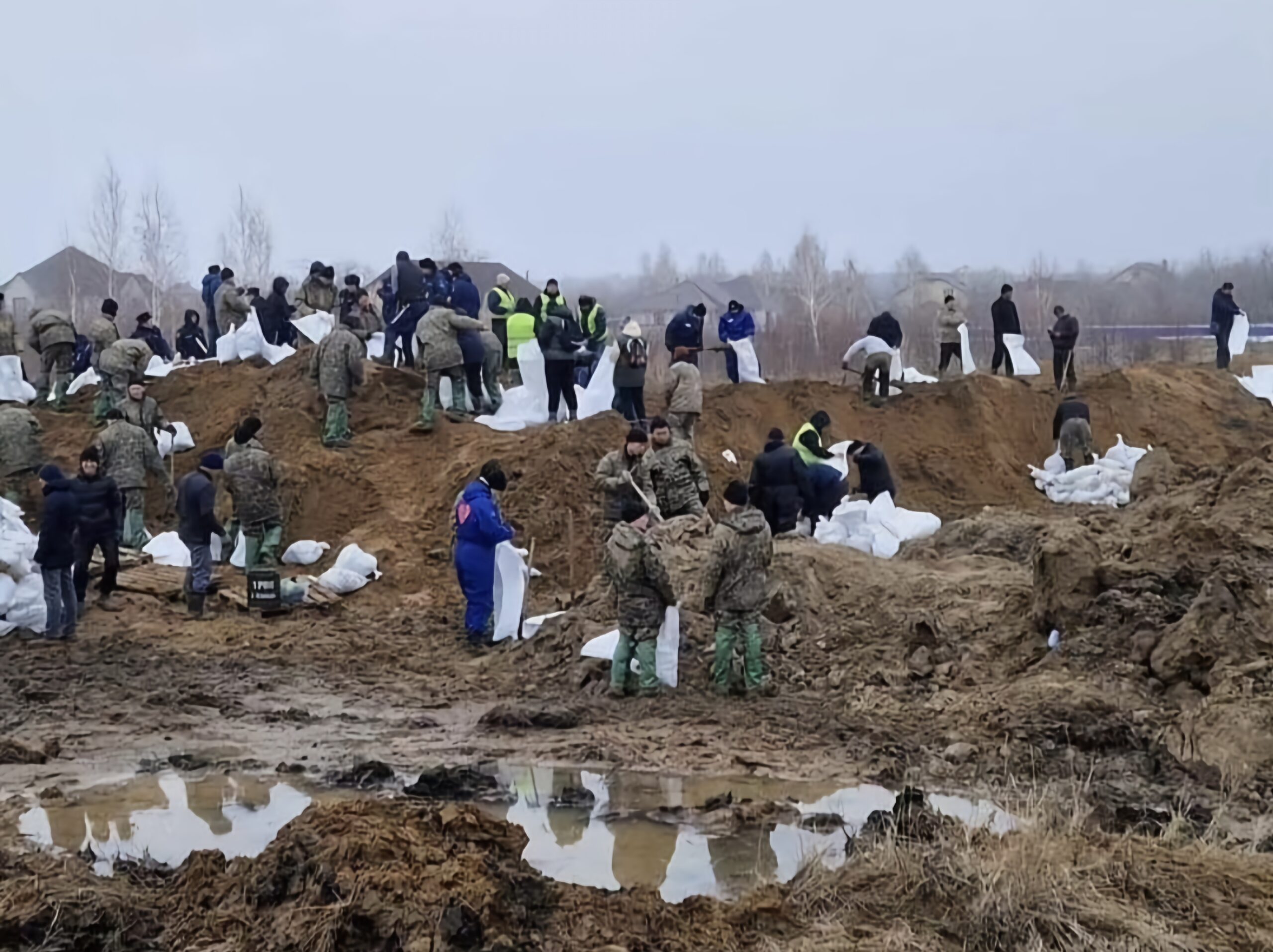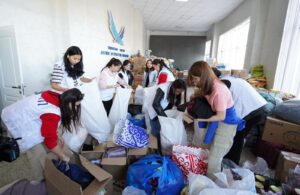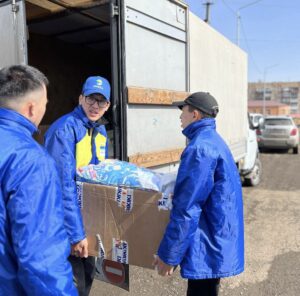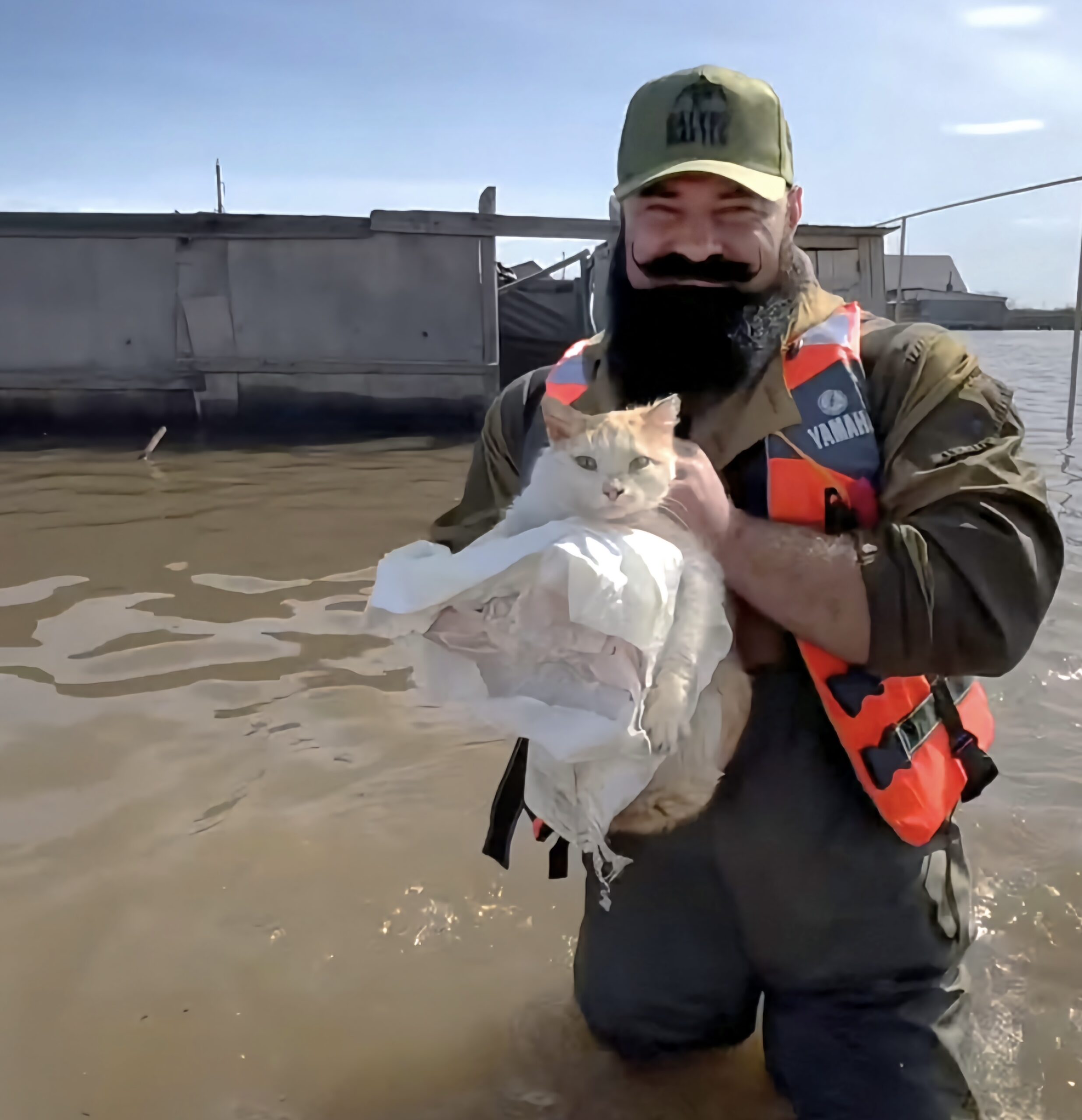ASTANA – The flood that began at the end of March has become one of the largest disasters in Kazakhstan in the past 80 years. Ten of Kazakhstan’s 17 regions were under a state of emergency. The floods affected thousands of people, displacing many from their homes and causing significant damage to infrastructure and agricultural land.

Volunteers fill sandbags for bank protection work. Photo credit: assembly_jastary_sko Instagram page
According to an April 23 statement from the Ministry of Emergency Situations, over 119,000 people, including over 44,000 children, have been evacuated from flood zones since the flood began.
Coordinating relief efforts
In an interview with The Astana Times, Tatyana Mironyuk, Executive Director of the National Volunteer Network, stated that during the floods, many volunteers stepped forward to assist those affected by the natural disaster. They provided food, shelter, and medical aid to the victims, and also assisted in evacuation efforts and coordinated relief efforts with local authorities.
“We led the general coordination of opening volunteer collection points for humanitarian aid in the flood-affected regions. These points were initiated by regional volunteer organizations and initiative groups. To date, such points have been opened in 16 regions of the country,” she said.

Volunteers from the Youth Resource center of the Turkistan Region sorting humanitarian aid to flood victims. Photo credit: National Volunteer Network
The network published the list of addresses of humanitarian aid collection points on its Instagram page.
Mironyuk highlighted that the network’s call center was temporarily transformed into a single contact center for coordinating assistance to victims and distributing volunteer forces.
“The contact center processes approximately 100 requests daily, including inquiries about humanitarian aid collection points, volunteer assistance opportunities, cash donations for flood victims, and volunteering,” she said.
Mironyuk noted that the call center even received inquiries from foreigners expressing their willingness to come and offer assistance, asking how they could help.
She expressed admiration for people who did not hesitate to help in various ways.
“Volunteers played a crucial role in providing relief to the affected areas and supporting the community during this difficult time. Their selfless actions and dedication to helping others in need were greatly appreciated by those impacted by the flood,” she said. “Volunteers’ readiness to extend a helping hand showcased the strength of community and solidarity during these times of crisis.”
The network also established an operational group to explain the algorithms for collecting humanitarian aid during emergencies and implementing instructions for regional offices based on the situation.
Volunteers showcase community resilience
According to the latest Ministry of Emergency Situations data, at least 31,416 people have returned home, while 8,560 people, including 3,717 children, are currently housed in temporary accommodation centers.

Volunteers of the Youth Resource center of the Akmola Region deliver humanitarian aid to flood victims. Photo credit: National Volunteer Network
Rescue efforts involve 31,000 people, including volunteers, 4,000 units of equipment, 763 water pumping devices, 298 watercraft, and 14 aircraft.
Meiramgul Yesniyazova, head of the Zhanyndamyn (I am near), a volunteer organization in Atyrau, highlighted that the volunteer headquarters in the region is open 24/7 and has been assisting since the beginning in the Aktobe Region.
“We organized a humanitarian aid collection point and were involved in gathering, sorting, and delivering humanitarian aid to the Aktobe Region. Around 8,000 tons of humanitarian aid were collected and dispatched,” she said.
Yesniyazova noted that shortly after the state of emergency was declared in Atyrau, a volunteer headquarters was set up, attracting many volunteers eager to help.
“At the moment, volunteers are working in two directions. First, they are sorting and distributing humanitarian aid received from all over Kazakhstan and neighboring countries to the town of Kulsary, where five villages were flooded. The second direction involves conducting shore strengthening work along the Zhaiyk River,” she said.
“In the beginning, there was a surge of volunteers, but the challenge lay in a shortage of inventory. However, as of today, the situation has stabilized,” she added.
Yesniyazova emphasized that both residents and concerned individuals from other regions, including foreigners working in Atyrau, have come forward to assist.
“My two children also provide all kinds of volunteer assistance. My 14-year-old daughter helps out on the dam, filling sandbags and preparing hot food and drinks whenever she has free time. And my 11-year-old son helps at the humanitarian aid collection point. No one looks at age, everyone helps. I always try to take my children to volunteer events so that they see various social conditions different people live in, understand that there are different types of families, and develop a sense of compassion, empathy, and mutual assistance,” said Yesniyazova.
She also noted that this situation has changed attitudes and understanding towards volunteering.
“There are numerous young people expressing interest in volunteering. Previously, during discussions and outreach efforts regarding volunteering, many perceived it solely as assisting elderly individuals, children from orphanages, or those with disabilities. However, now that young people have engaged in activities like shoveling and filling sandbags, their perceptions have shifted,” she said.
The North Kazakhstan Region empowers volunteers
In the North Kazakhstan Region, the flood situation remains persistently challenging.
Anastasia Volkova, the director of the Volunteers’ Front Office in the North Kazakhstan Region, discussed the establishment of an operational headquarters for rapid-response volunteers.
“The headquarters conducts training and coordinates the work of more than 2,500 volunteers. Seven mobile captains in the city are responsible for each group. The guys are divided into several directions: heavy work (physical work, filling sandbags), evacuation group, and a group for organizing food for those involved in physical work,” she said.
Volkova also noted that volunteers are also involved in organizing recreational activities for children currently residing in temporary accommodation centers.
“Loss of home and the disruption of familiar routines are deeply stressful experiences for both adults and children. However, children often face additional challenges due to their limited understanding of the situation. Therefore, to avoid deep stress, we try to distract the children, conduct various workshops, come up with different scenes involving the children themselves so that they also feel safe,” she said.
Athletes’ support
Kazakhstan’s renowned athletes did not stand aside either. Sergey Tsyrulnikov, a Kazakh athlete with four Guinness World Records also traveled to Uralsk to assist.

Sergey Tsyrulnikov evacuated pets in the flooded areas. Photo credit: Tsyrulnikov’s Instagram page
“I was in the United States when the floods began, and the first thing I did was provide financial assistance. After returning, I immediately went to Uralsk with Dala Kyran, a public youth organization,” he said.
Tsyrulnikov said that he spent three days there helping to build the dam and evacuate animals.
“On the first and last day, we helped lay sandbags and built protective dams. We started at 9 a.m. and worked until 9 p.m. Specialists from the Ministry of Emergency Situations took over at night, ensuring work continued around the clock,” he said.
Tsyrulnikov emphasized that all residents in the flooded areas were evacuated, but unfortunately, they could not take their pets with them, leading to their involvement in the animal evacuations as well.
“We found animals in various places, some in the water, some on elevations. They all behaved obediently, non-aggressively. At times, we had five to seven cats and dogs in one boat,” he said.
“It was heartening to see everyone working together, regardless of age, social status, or gender, side by side. The fishing community played a significant role by bringing their boats and providing assistance. Several well-known athletes, including Daniyar Yeleusinov, who was preparing for a fight at the time, also joined in to lend their support,” Tsyrulnikov added.

